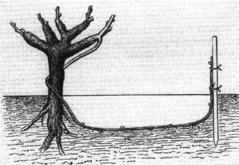At Château de Nages, we’ve always known that winemaking is an ancient story here. What a surprise when it was revealed before our very eyes!
A few years ago, when construction work at the estate required archaeological excavations, INRAP’s research showed that some of our plots were on a wine-growing site dating back to ancient times. To think that we’re doing the same vocation – and in the same place – as those who preceded us by two millennia gives meaning to our work. It goes beyond tradition, encroaching on the sacred for us. More concretely, it validates the relevance of our terroir.
As for the excavations themselves, they highlighted geometric shapes resembling almost a ladder (figure below). Delineated by gray lines in red / brown soil, the archaeologists told us that the gray color comes from the decomposition of organic matter: these traces confirm the remains of vineyards established during the period Roman.

Other sources back this observation. Columella, an Andalusian writer of the 1st century BCE, wrote important treatises on agriculture practices of his time and has extensively documented how vineyards were established in the Roman Empire. Our ancestors would dig a trench in which they plowed the earth 90cm deep and then planted a row of vines. Later, using the technique of “layering” or marcotting (see figure below), they pulled a branch of each vine that they buried in a perpendicular axis to establish on the other side of the trench a shoot that would produce another vine (hence the ladder shape of the vineyard).

This technique allowed the young plants to establish themselves before doubling the vineyard’s size. This clever approach optimized the quality of the plantation and reduced its costs. Since the arrival of phylloxera, this method unfortunately is no longer feasible.
In Roman times, wines from the Rhône Valley were very popular. They were exported to all corners of the empire, as evidenced by the remains of amphorae from the site of Tourelles, also in Costières de Nîmes, found in Italy and the Rhine provinces.
We always say that great terroirs never die. This discovery made us want to produce a great wine from this historic terroir. It is undoubtedly very different from the wine produced here back then. But the voice of its terroir remains the same; that’s what we want to share with you today.
Thus VOX is born!
To enter our website, you must be of legal drinking age in your country.